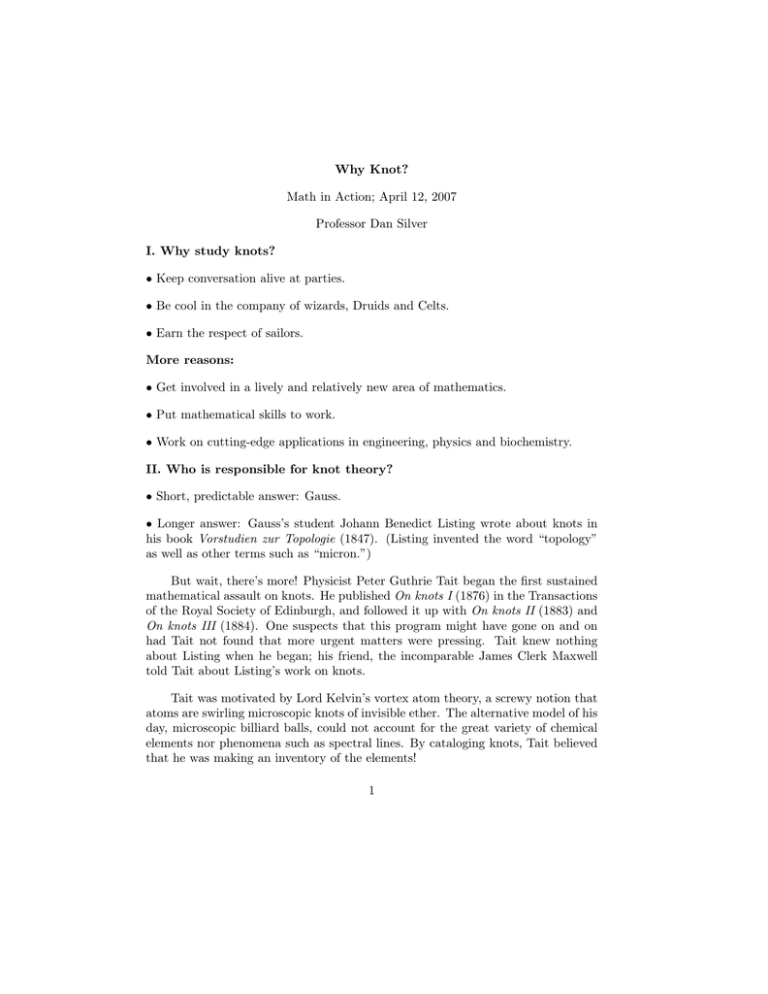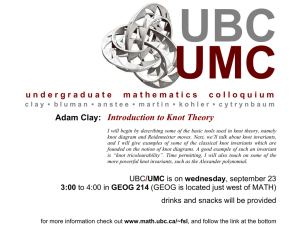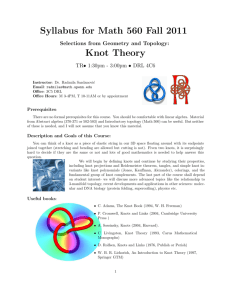Why Knot? Math in Action; April 12, 2007 Professor Dan Silver
advertisement

Why Knot? Math in Action; April 12, 2007 Professor Dan Silver I. Why study knots? • Keep conversation alive at parties. • Be cool in the company of wizards, Druids and Celts. • Earn the respect of sailors. More reasons: • Get involved in a lively and relatively new area of mathematics. • Put mathematical skills to work. • Work on cutting-edge applications in engineering, physics and biochemistry. II. Who is responsible for knot theory? • Short, predictable answer: Gauss. • Longer answer: Gauss’s student Johann Benedict Listing wrote about knots in his book Vorstudien zur Topologie (1847). (Listing invented the word “topology” as well as other terms such as “micron.”) But wait, there’s more! Physicist Peter Guthrie Tait began the first sustained mathematical assault on knots. He published On knots I (1876) in the Transactions of the Royal Society of Edinburgh, and followed it up with On knots II (1883) and On knots III (1884). One suspects that this program might have gone on and on had Tait not found that more urgent matters were pressing. Tait knew nothing about Listing when he began; his friend, the incomparable James Clerk Maxwell told Tait about Listing’s work on knots. Tait was motivated by Lord Kelvin’s vortex atom theory, a screwy notion that atoms are swirling microscopic knots of invisible ether. The alternative model of his day, microscopic billiard balls, could not account for the great variety of chemical elements nor phenomena such as spectral lines. By cataloging knots, Tait believed that he was making an inventory of the elements! 1 III. What is a knot knot? What is a knot invariant? Take a stretchable cord. Arrange it in any way. Now connect its ends. The result is a knot. Two knots are the same if one can be pulled, twisted (but not broken!) to be identical with the other. It is relatively easy to prove that two knots are the same: simply demonstrate by pulling and twisting. It is far more difficult to show that two knots are different. There are infinitely many ways to deform, and we cannot rule them all out by physical trial. It takes an idea. It takes mathematics. Our watchword: Mathematics - turning reality into ideas. How to describe a knot. We could try to describe knots as graphs of functions, but that is much too hard. Instead, we simply draw a diagram. A knot can be described by many different diagrams. A wonderful theorem tells us that any diagram for a given knot can be converted into any other by applying only 3 basic diagram changes or “moves.” This means that we can really study knots by means of diagrams. 2 Because these moves were discovered and used effectively by Kurt Reidemeister in the 1930s, today they are called Reidemeister moves. Kurt Reidemeister (1893-1971) Definition. A knot invariant is a quantity defined for a knot. If an invariant differs for two knots, then they must be different. But how can we find knot invariants? Length, for example, is not an invariant. We must look deeper. Suppose that we can define a quantity for knot diagrams that does not change when any of the three Reidemeister moves is applied. Such a quantity must be a knot invariant. 3 IV. Fox p-coloring. We look at one of the simplest, useful invariants for knots. Remember that Z/p is the field of integers modulo p, where p is a prime. We write 0, 1, 2, . . . , p − 1, but we must remember that a + b is the remainder obtained when we divide by p. For example, in Z/5, the sum 3 + 4 is equal to 2. We call 0, 1, . . . , p − 1 “colors.” “When I use a word,” Humpty Dumpty said, in rather a scornful tone, “it means just what I choose it to mean – neither more nor less.” “The question is,” said Alice, “whether you can make words mean different things.” “The question is,” said Humpty Dumpty, “which is to be master – that’s all.” Through the Looking-Glass – Lewis Carroll Definition. A p-coloring of a knot diagram is a labeling of its arcs by colors so that at any crossing the sum of the colors of undercrossing arcs is equal to twice the color of the overcrossing arc. a c b 2a=b+c 3-colorings are called tri-colorings. Think of 0, 1, 2 as, for example, red, green and blue. There are the 9 tri-colorings of the usual diagram of a trefoil knot: 4 Here are some things to notice. • We can add p-colorings of any diagram to get new p-colorings. • We can multiply a p-coloring of any diagram by a “scalar” in Z/p to get another p-coloring. It's a vector space! A photograph of Ralph Fox taken on his 60th birthday 5 Definition. The p-coloring space of a knot diagram D is the vector space of all its p-colorings, denoted by Colp (D). Theorem. If D and D0 are two diagrams of the same knot k, then Colp (D) is isomorphic to Colp (D0 ). Sketch of proof. Look at the effect on Colp (D) of each of the three Reidemeister moves. Corollary. Colp (D) is a knot invariant of k. Because of the corollary, we can speak of the p-coloring space of the knot k itself. We denote it by Colp (k). Every p-coloring space has p trivial colorings for which each arc receives the same color. Trivial p-colorings form a subspace, and if we mod out by it, we get the based p-coloring space Colp0 (k). It is easy to compute directly: pick any arc of your favorite diagram for k, and require merely that the arc always be colored with 0. Example. The 3-coloring (tri-coloring) space of the trefoil has dimension 3. (The based space has dimension 2.) What about the p-coloring space for other primes p? Calling the two nonzero colors a and b, we find that we need: b = 2a a = 2b a+b=0 Substituting the value of b from the first equation into the second, we get 3a = 0. When we substitute into the third equation, we find that it is redundant. Unless p = 3, all the solutions to the system are trivial. We conclude that for the trefoil Colp0 (k) is zero unless p = 3. Can you see why the dimension of Col30 (k) is 1? Example. Here is another knot, called Listing’s knot or the figure-eight knot. 0 c a b 6 For what primes p does Listing’s knot have nontrivial p-colorings? To find out, we must solve a system of linear equations: b+c=0 c = 2a a = 2b a + b = 2c equivalently: b+c=0 c − 2a = 0 a − 2b = 0 a + b − 2c = 0. Notice that the sum of the equations is trivial. This means that any one equation is a linear combination of the others. (Using some topology, we can see why this is generally true for all knot diagrams.) We can throw away the last equation. Linear algebra tells us that the system of 3 equations in 3 unknowns can be solved using matrices: 0 a 0 1 1 −2 0 1 b = 0 1 −2 0 c 0 There is a nonzero solution exactly when the determinant of the 3 × 3 coefficient matrix vanishes. Since the determinant is 5, we must work in the field Z/5 if we want nontrivial colorings. The determinant of the matrix is also called the determinant of k. It is itself a knot invariant. “When I make a word do a lot of extra work like that,” said Humpty Dumpty, “I always pay it extra.” Colorings will not tell apart all knots. In fact, there are knots that have only trivial p-colorings for every prime p. Knot theorists use many other invariants. One of the most powerful was discovered accidentally by Berkeley mathematician 7 Vaughan Jones in 1985. Many questions about the so-called Jones polynomial and other new recently discovered invariants remain to be answered. Classifying knot invariants is as difficult – and important– as classifying knots themselves! V. The future of knot theory. Mathematicians often study something simply because it “feels right.” The depth of a topic can sometimes be sensed, and that sense is enough to justify many hours, or years, of work. Still we might ask: What are the applications of knot theory? First, knots have applications in pure mathematics. For example, they enable us to describe and study 3-dimensional manifolds, spaces that appear locally like ordinary Euclidean space but are in fact different. What 3-dimensional manifold do we live in? We don’t yet know. Although bending a knot doesn’t change its “topological identity,” it does affect geometric structure. What happens if we dip a copper-tube knot into a bucket of soap solution? The film that forms is really two surfaces with a layer of air between them, but as the film is so thin, we can think of it as a 2-dimensional surface. Bending the knot can change the type of surface. Nevertheless, in all cases physics dictates that we get a surface of minimum area bounding the knot. Such a minimal surface solves “Plateau’s Problem.” Notice the saddle shape. Euler showed that all (non-plane) minimal surfaces must have such a shape. 8 Applications of knot theory to the physical and biological sciences are newer. Knots arising in fluid flows and solar flares, for example, reveal deep, hidden structure. Long molecules exhibit knotting, too. Today biochemists study recombination by treating circular DNA with enzymes called topoisomerases. And Jones’s discoveries have suggested surprising connections between knots and physics, connections that Lord Kelvin and Tait could not have imagined. The deepest applications of knot theory have probably not yet been found. Don’t be surprised by that. After all, Apollonius had to wait nearly 2,000 years for Johannes Kepler to discover that the shape of a planet’s orbit is an ellipse. We have much yet to learn about knots. Acknowledgments. Images of knots from Wolfram MathWorld, Wikipedia and www.popmath.org.uk, used with permission. Copper-tube knots were given by Nathaniel Friedman. Photograph of soap-film knot by Susan G. Williams. 9




